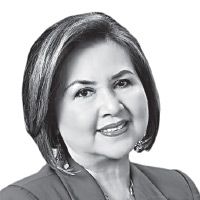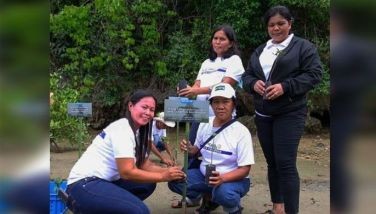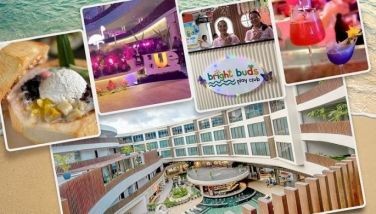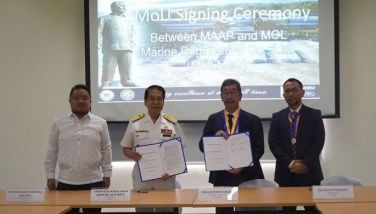What the Latter-Day Saints missionaries learned about the Filipinos

June 16, 2005 | 12:00am
What is the Church of Jesus Christ of the Latter-Day Saints (LDS)?
One of them, Craig Manscil remarked, "Our founder Joseph Smith introduced the concept of the ‘caring society’." While Paul Hoskinson stressed that democracy can’t function unless the people are educated and morally responsible. Fred Woods recalled that as a young man, he wasn’t a Mormon, but his girlfriend was. Her commitment to Christ’s teaching as she involved herself in helping others so impressed him that he got converted. Speaking of the Mormon way, Mary Jane Woodger said, "We shepherd each other!"
Laying the foundations, 1961-1980
It took almost two decades to legally establish the LDS mission in the Philippines. The General Authorities of the Church from Salt Lake City, Utah who worked on this was led by Elder Gordon B. Hinckley (the current LDS president) and President Robert S. Taylor of the Southern Far East Mission.
Usually the Asian Missions were ignited first by LDS military servicemen and women, US government employees, and businessmen. In the Philippines, they were in Gen. Douglas MacArthur’s advancing forces in 1944. Much later, with the Korean War military build up, LDS servicemen were either in Sangley Point, Clark Field or Subic Bay.
The visas of the missionaries were denied at first, so Elder Hinckley and President Taylor had to convince the officials of the Department of Foreign Affairs that they "would not be a burden on the economy or a problem for the government". They started accepting the mission in 1961, which encouraged them to hold a sunrise service at the Fort McKinley War Memorial Cemetery in Makati.
In that calm and beautiful setting surrounded by the graves of thousands of American war heroes, Elder Hinckley’s prayer of rededication was particularly prophetic and meaningful: "We invoke Thy blessings upon the people of this land that they shall be friendly and hospitable… Lord, we pray that there shall be many thousands who shall receive this message and be blessed thereby. …that Thy work here shall be handled largely by local brethren, under the direction of those who hold the keys in this day and time, according to the law and order of Thy Church."
Considering the amazing success of the Church in the Philippines (approximately 20,000 members by 1975 and 370,000 by 1996), one wonders why the Church is doing so well in the country in comparison with Thailand, Japan, or areas in China. The explanation lies almost entirely in the historical development of the Philippines.
"The Philippines is like an onion. The thin outside skin of the onion is American — the first things that impress the visitor to Manila are the Stars and Stripes that flew over the country for 48 years, from 1898 to 1946 (interrupted by four years of Japanese occupation from 1942-45)."
"Peel off the outside skin of the onion and the next layer is Spanish. Spain’s rule in the Philippines (1565-1898), the most important is the nominal Catholicism, which claims almost 85 percent of the people still today."
"Then, peel off the Spanish layer and you come to the hard and durable core of Filipino life, which is Malay-Indonesia. Proverbs and values, the family system, and personal relationships are played by ancient tribal rules."
"This make believe onion is still an organic unit, for Juan de la Cruz functions during office hours as an American, goes to Mass on Sunday morning like a Spaniard, and rules his home like a traditional Filipino. He is a mixture of East and West, old and new. Sometimes the conflict disturbs him, but most of the time he does not stop to think about the disparate influences which mold his life."
Elements of all parts of this complex have combined to help the LDS Church succeed in the Philippines. Americans are generally respected and welcomed. They not only provided equitable government, but they also liberated the islands at the end of World War II. Two remnants of the colonial era are a feeling of democracy and the adoption of the English language. Up to the present, America is the Philippines’ number one trading partner even though some inequities have caused problems.
The most important carryover from the Spanish era for LDS missionary work is Christianity. In 1565, only the southwestern tip of Mindanao had been converted to Islam, but the people became nominally Christian. It is much easier to convert an English-speaking Christian to the restored gospel than a Chinese-speaking Buddhist or Daoist.
At present, the religious makeup of the nation is 83 percent Roman Catholic, 9 percent Protestant, 5 percent Muslim, and 3 percent others such as animism and Chinese faiths. Converts come into the LDS Church in almost these same proportions, particularly from Catholicism and Protestantism. (Britsch, Lanier, From the East, 1998)
All Asian peoples place high value on the family unit and its role in society. In contrast to the Confucian areas of China, Korea, Japan, and Vietnam, where importance is placed on rigid familial propriety, in the Philippines the emphasis is on FAMILY LIFE AND SOLIDARITY. Thus, at the end of the first decade of missionary work, more than 35 percent of all married members had mates who belonged to the Church, and almost 50 percent had brothers and sisters who were married.
There are at least 87 languages spoken in the Philippines. The great majority of the people use one of four native languages: Tagalog, which is the basis for Filipino (the national language), Ilocano, Hiligaynon (Ilonggo) and Cebuano. But, English is the real lingua franca of the nation. It is used in government, business, education and communications. Thus, the servicemen and their families were able to communicate with the locals, and they developed strong bonds of fellowship. In Manila, near Clark Air Force Base and Subic Bay Naval Stations, there was no period of struggle while the Filipinos learned from the missionaries how to conduct meetings and organize the Church. Filipino leaders saw the advantage of older role models to emulate, rather than youthful, inexperienced missionaries.
Although literacy is relatively high and many members of the Church have post-high school education, too often training and degrees are in non-technical areas that lead to educated unemployment. Church members not only struggle with economic and educational challenges, but they also suffer with many health problems. Infant morbidity is relatively high in the Philippines, and Church members have not escaped this sorrow. Numerous other health problems exist that cause untold suffering among people of all ages. Missionaries, too, Filipino and foreign, have been infected with hepatitis, tuberculosis, worms, and other parasites.
It turned into a whole district project to have some classes on maternal and child health. This woman participated and did everything she possibly could. It meant changing a lot of traditions and going against some deeply ingrained customs, but she trusted and was motivated by concern for her unborn child. She realized that she was preparing an earthly body for one of Heavenly Father’s spirit children.
Pretty soon her neighbors, most of whom weren’t members of the Church, began to talk about the ‘Mormon baby’. When the baby was born, she was larger and healthier than any baby that neighborhood had ever seen. The parents were so proud. They couldn’t be persuaded that the Word of Wisdom and proper sanitation weren’t principles of the gospel when they saw the difference it made to their child.
(Next week: Part 3, Church Welfare in the Philippines)
(For more information or reaction, please e-mail at exec@obmontessori.edu.ph or pssoliven@yahoo.com)
BrandSpace Articles
<
>
- Latest
- Trending
Trending
Latest
Recommended

March 16, 2025 - 6:18pm

March 15, 2025 - 12:00am


























